Step by Step on The Way of Saint James
From Astorga to Foncebadón
2 June 2018
Stage 23 – Km. 25

– From today, we say goodbye to the plains! –
The route we are about to take will be a continuous ascent, crossing the Montes de León, located in the west of the province of the same name.
Astorga lies at 875 meters above sea level, while the day after tomorrow, we will reach an altitude of 1,531 meters near the Cruz de Hierro—the highest point on the entire French Way.
Although my legs no longer hurt, I want to be cautious for a few more days, so I choose to send my backpack ahead by courier.
The demanding uphill route and my still uncertain recovery suggest that I should not take any risks, continuing for now as a “comfortable pilgrim,” without a backpack on my shoulders.
– I’ve said it before: I prefer this solution rather than going home, interrupting The Way due to serious physical issues. –
Today, I also grant myself another convenience: I book tonight’s accommodation for myself and the friends walking with me.
At the end of the stage, we will arrive in Foncebadón, where the municipal hostel has only 18 beds, and apart from this, there are not many other accommodation options. These numbers are too limited to leave it to chance and risk not finding a place to sleep; moreover, not booking would mean having to hurry to reach our destination as soon as possible.
Since it is not possible to reserve spots in municipal hostels, I book a private one.
We set off at 6:30, and with me are Rocco, Giulia, and Giovanna.
It’s not cold, the sun is shining, I have no backpack to carry, I’ve booked a bed, the route looks promising, I’m in good company, and, most importantly, I feel quite fit:
– What more could I ask for? –
Everything seems perfectly aligned, so I have no choice but to enjoy this new day on The Way.
Leaving the hostel, the very first stretch of the route takes us through the historic center of Astorga; thus, as we walk away, we get a last glimpse of the city’s beauty—the plaza Mayor, Gaudí’s palace, the cathedral, and everything else.
After passing the hermita of Ecce Homo and then the bridge crossing the Autovía del Noroeste, we can consider ourselves outside Astorga. From here onwards, we leave the tarmac and continue along a dirt path.
Around eight o’clock, we pass through Murias de Rechivaldo, and after another hour of walking, we arrive at Santa Catalina de Somoza.
At the entrance to the village, we are greeted by the simple iglesia parroquial de Santa María, which houses a relic of the patron saint, San Blas.
The small urban center is rather charming, consisting of stone houses built in simple, traditional style. Some are semi-ruined, abandoned to the mercy of time, while others are well restored, showing signs of daily life, such as the care of flowering plants that decorate the facades.
There are a couple of “albergue for pilgrims” and even bars with outdoor tables that contribute to bringing the village to life.
About fifty people live in Santa Catalina de Somoza. The locality, like many others along The Way, represents both the depopulation of small rural centers and their slow rebirth thanks to the growing flow of pilgrims passing through daily.
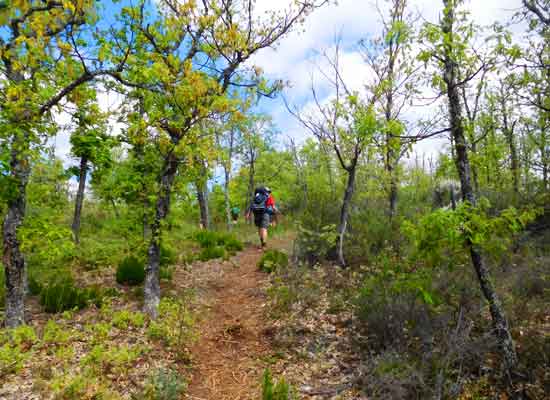
From Santa Catalina de Somoza, we already notice a change in the type of buildings—simple and ancient-looking houses.
The climate and vegetation also shift, adopting the characteristics of a mountain environment. As we continue, the landscape becomes increasingly majestic and solitary.
The itinerary is a continuous gentle ascent, winding along the slopes of the Montes de León.
After another hour of walking, we arrive at El Ganso, another small village on the road to Santiago de Compostela, which shares the same features as the previous one—rural, small, charming, and welcoming.
We are now at an altitude of 1,010 meters.
The number of residents here is really small—about thirty-five.
The parish church is dedicated to Saint James, who is also the patron saint of the village.
At the entrance to El Ganso, there is a bar frequented by pilgrims—the Cowboy, a unique and slightly alternative place.
– I wonder why they chose a name evoking the American West? –
Displayed at the entrance, an advertisement for San Miguel beer, with the slogan “Falta poco. Relájate con San Miguel,” encourages pilgrims not to give up and, at the same time, invites them to take a break before continuing.
Just beyond the village, the incline of the path becomes steeper as it climbs up the Montes de León. We are now approaching the region of Bierzo, a transitional zone between the province of León and Galicia.
The route alternates between asphalt sections and dirt paths, while the surroundings present tall, dense, and sometimes forested vegetation.
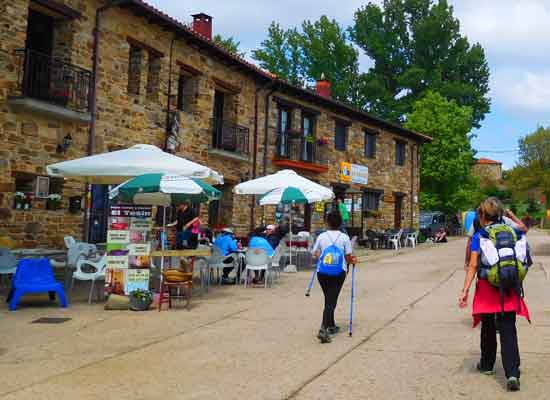
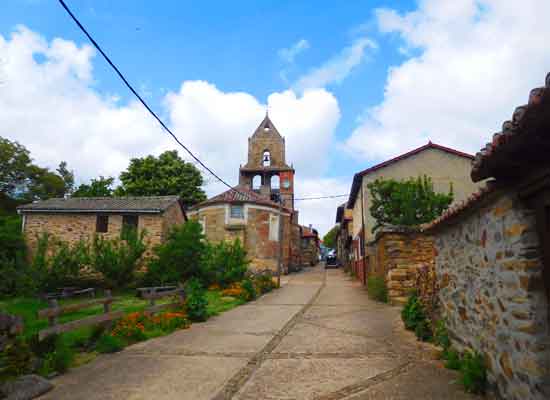
By noon, we arrive in Rabanal del Camino.
So far, we have covered just over twenty kilometers.
The village is one of the classic stops on the French Way, where pilgrims usually spend the night.
However, staying here would mean tackling a nearly 33-kilometer stage tomorrow.
Therefore, we prefer to continue for another five kilometers to reach our next destination, Foncebadón.
We still take an hour’s break to soak in the atmosphere of this delightful little village.
Since we have already booked tonight’s hostel, we can afford to take our time instead of rushing to arrive early.
We allow ourselves to relax and enjoy the surroundings of Rabanal del Camino, a village that maintains its charm thanks to traditional stone buildings. Here too, the local economy revolves around The Way of Saint James.
Although only about a hundred people live here, the village feels much more alive than the previous ones. This is partly due to its capacity to accommodate pilgrims—approximately 170 beds spread across four hostels.
In the 12th century, the village served as a post for the Knights Templar, whose mission was to protect pilgrims passing through this section of The Way.
Several religious buildings enrich the historic center: two hermitages, a church, and a monastery.
At the village entrance, we encounter the hermita del Bendito Cristo de la Vera Cruz, dating back to the 18th century.
Also from the same period, along the calle Real, stands the hermita de San José, which houses an interesting Baroque altarpiece.
Higher up in the village, we find the iglesia de Nuestra Señora de la Asunción, which has Templar origins and was built in the 12th century in Romanesque style. Its bell tower contains a unique 19th-century clock.
Next to the church, there is the small Benedictine monastery of San Salvador del Monte Irago, where pilgrims can participate in various liturgical celebrations.
In the calle Real, there is a grocery store run by María José, a lovely red-haired woman who welcomes pilgrims with a warm smile.
Across the street from the shop is the Green Garden, also managed by the same friendly lady. This spacious garden with an English-style lawn is equipped with tables, benches, chairs, hammocks, umbrellas, and gazebos—perfect for taking a break and enjoying a snack.
For those carrying tents, there is a dedicated space at the end of the garden where free camping is allowed. In this case, guests are welcomed, and a “donation” is appreciated.
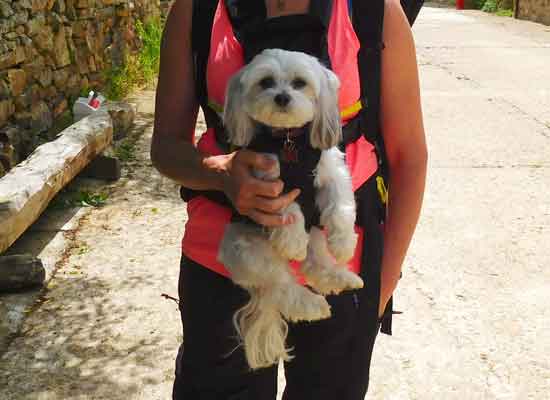
Before leaving the village, I chat briefly with a young pilgrim walking The Way of Saint James accompanied by her small, long-haired white dog—probably a Maltese or a similar breed.
What I find curious is that she carries the dog strapped to her chest in a harness.
So, besides her backpack, she has this additional burden to carry.
Even though the dog is small—perhaps weighing about three kilos—it still adds a significant load, going against the recommended maximum weight to carry.
Encountering pilgrims with dogs along The Way is not uncommon. However, those who choose to bring their four-legged friends must account for the difficulty of finding accommodation, as most hostels either prohibit animals outright or severely limit their access to dormitories.

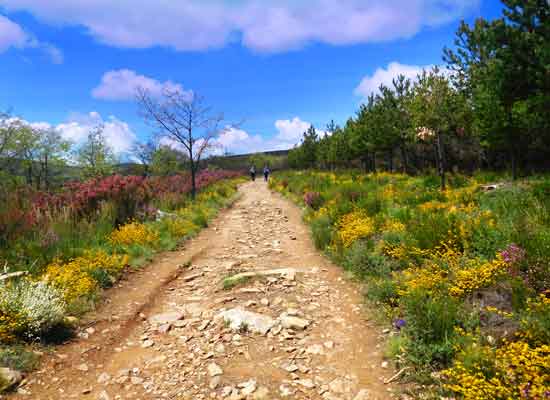
Shortly after one o’clock, we leave Rabanal del Camino and resume walking to complete the final kilometers of today’s stage.
From here, the incline becomes steeper, and in just over five kilometers, we will climb approximately 300 meters in altitude.
The landscape becomes increasingly wild and, at the same time, incredibly fascinating.
The path winds through green oak forests, which occasionally open up into vast clearings. In these open spaces, the predominant color is the white of small heather flowers, punctuated here and there by tufts of yellow gorse that add a splash of color to the pristine floral carpet.
The blue sky and the mountain atmosphere invigorate both the eyes and the mind. As we ascend, the air becomes fresher and clearer.
Mother Nature, undoubtedly the greatest artist among the Impressionist painters, completes the scene as we pass by, adding a small detail to the landscape—a vibrant green lizard with a bright blue head, a feature that identifies males during the mating season.
I like to think that this little reptile is resting on the edge of the path, waiting for its mate.
I slow my pace—not because of the incline, but rather to fully enjoy the beautiful scenery.
I’m in no hurry and can afford to take my time, especially since I’ve already called the hostel to let them know we’ll be arriving a bit later than expected.
The weather is mild—in fact, it’s even warm enough for me to shed my heavier clothing and walk in just my t-shirt. – Finally! –
At 14:20, we arrive in Foncebadón, a small village at the foot of Monte Irago, located at an altitude of 1,460 meters.
We are now very close to reaching the highest point of The Way.
We stay at the Albergue Monte Irago, which is private rather than municipal and costs 9 Euros—slightly more than usual.
The hostel can accommodate 34 people, which is about half the total capacity of the three “albergue” in the village.
As usual, upon arrival, we go through the same routine—shower, laundry, and then a meal.
Taking advantage of the beautiful sunshine, we sit outside and share a snack with what we have on hand.

In the Middle Ages, Foncebadón was an important stop along the road to Santiago de Compostela, offering passing pilgrims shelter in a convent and a couple of “hospitales.”
Between the 19th and mid-20th centuries, the village gradually depopulated until it was completely abandoned, and the buildings fell into ruin.
Only recently, thanks to The Way of Saint James, Foncebadón has slowly begun to recover, attracting alternative tourism in the form of modern-day pilgrims.
The constant flow of travelers has encouraged “pioneers” to invest in the restoration of some of the village’s most significant buildings, betting on its revival.
It was only a few years ago that the first stretch of calle Real was paved, while the rest of the road remains a dirt track.
Foncebadón is so small that there’s no afternoon sightseeing tour to take; a short walk of 200–300 meters from the hostel is enough to cover the entire village.
We take the opportunity to enjoy the sun until the weather suddenly changes, forcing us to retreat indoors due to the rain.
Salami, cheese, vegetarian paella, and fruit make up the fixed dinner menu, served at seven o’clock sharp in the same “albergue” where we are staying.
We dine together in the small ground-floor dining room, which has the feel of a cozy mountain refuge.
At our table, we meet an Italian couple walking The Way partly on foot and partly by rented bikes.
By 21:30, we head to bed.
| © Aldo Lardizzone 2020 |  |
CREATIVE COMMONS |
Stage 24 - From Foncebadón to Ponferrada



